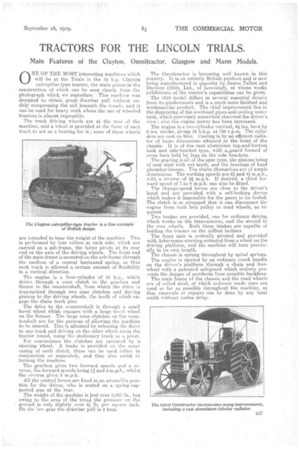TRACTORS FOR THE LINCOLN TRIALS.
Page 15

If you've noticed an error in this article please click here to report it so we can fix it.
Main Features of the Clayton, Oinnitractor, Glasgow and Mann Models.
• ONE OF ma s
-THE MOST interesting chine which will be at the Trials is the 35 h.p. Clayton caterpillar-type tractor, the mainpoints in the construction of which can be seen clearly from the photograph which we reproduce. This machine was designed to obtain great. drawbar pull Without unduly compressing the soil: beneath the treads, and it can be used for heavy work where the use of wheeled tractors is almost impossible.
The track driving wheels are at the rear of the machine, and a wheel is Provided at the front of each track to act as a hearing for it ; none of these wheels
are intended to bear the weight of the machine. This is performed by four rollers at each side, which are carried on a sub-frame, the latter pivots at its rear end on the axle of the driving wheels. The front end of the main frame is mounted on the sub-frame through the medium of a central laminated spring, so that each track is allowed a certain amount of flexibility. in a vertical direction.
The engine is a four-cylinder of 35 h.p., which drives through a cone clutch to the gearbox and thence to the countershaft, from which the drive is transmitted through two cone clutches and driving pinions to the driving wheels, the teeth of which engage the chain track pins.
The drive to the countershaft is through a small bevel wheel whiali engages with a large bevel wheel on the former. The large acne clutches on the countershaft are for the purpose of allowing the machine to be steered. This is .attained by releasing the drive to one track and driving an the other which turns the tractor round using the stationary track as a pivot.
For convenience the clutches are operated by a steering wheel. A brake is provided CM the outer casing of each clutch, these can be used either itt conjunction or separately, and they also assist in turning the machine.
The gearbox gives two forward speeds and a reverse, the forward speeds being 1/ and 4 m.p.h., whilst the reverse gives .3 m.p.h.
All the eontrol levers are fixed in an accessible position for the driver, Who is seated on a spring-supported pan at the rear.
The weight of the Machine is just over 5,000 lb., but owing to the area of the 'tread the pressure on the ground is only slightly over 21 lb. per square inch. On the low gear the drawbar pull is 2 tons.
. The Oinnitractor is becoming well known in this country. It is an entirely British product and is now being manufactured in quantity by James Talbot and Davison (191), Ltd., of Lowestoft, at whose works eXhibitions of the tractor's capabilities can be given.
The 1919 -model differs in several essential details from its predecessors and is a much more finished arid workmanlike product. The chief improvement lies in the dispensing of the overhead pipes and cooling water tank, which previously somewhat obscured the driver's view ; also the engine power has been increased.
The engine is a two-cylinder vertical, 6i ins, bore by 9 ins. stroke, giving 35 b.h.p. at 750 r.p.m. The cylinders are cast en bloc. Cooling is by an efficient radiator of large dimensions situated at the front of the chassis. It is of the cast aluminium top-and-bottom tank and side-bracket type, with a,guard formed of cross bars held by lugs on the side brackets.
The gearing is all of the spur type, the pinions being of cast steel with cut teeth, and the bearings of hard phosphor-bronze. The shafts themselves are of ample dimensions. The working speeds are 212 and 4i m.p.h., with a reverse of at m.p.h. If desired, a third forward speed of 7-to 8 m.p.h. can also be fitted.
The change-speed levers are close to the driver's hand and are provided with a self-locking device which makes it impossible for the gears to'be fouled. The clutch is so arranged that. it can disconnect the engine from both belt pulley or road wheels, as required. Two brakes are Provided, one for ordinary driving which works on the transmission, and the second to the rear wheels. Both these brakes are capable of holding the tractor on the stiffest inclines.
The front axle is centrally pivoted and provided with Ackermann steering actuated from a wheel on the driving platform, and the machine will turn practically in its own length. The chassis is sprung throughout by spiral springs.
The engine is started by an ordinary crank handle on the driver's platform through a chain and freewheel with a patented safeguard which entirely prevents the danger of accidents from passible backfires. The main frame of the chassis and the road wheels are of rolled steel, of which ordinary trade sines are used so far as possible throughout the machine, so that renewals or repairs can be done by any local smith without undue delay.
























